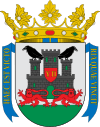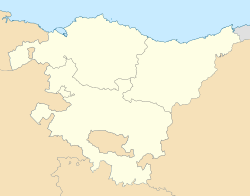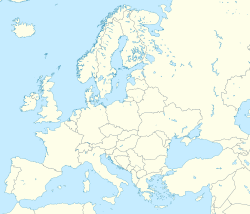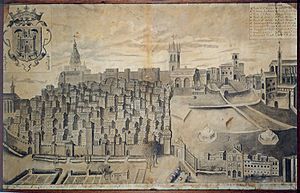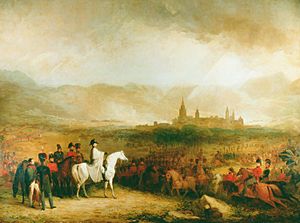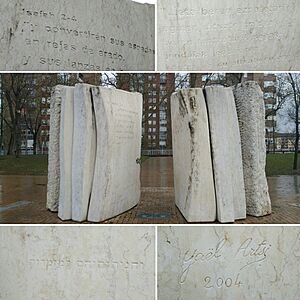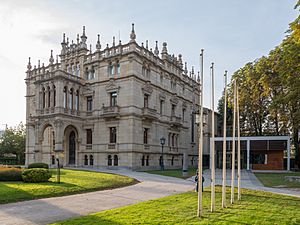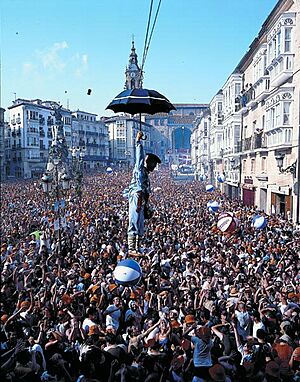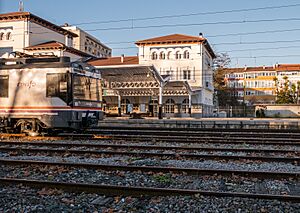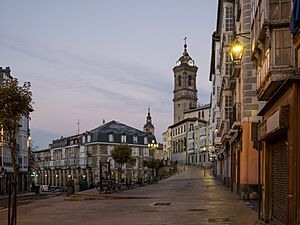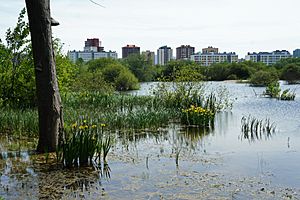Vitoria-Gasteiz facts for kids
Quick facts for kids
Vitoria-Gasteiz
Gasteiz (Lua error in Module:ISO_639_name at line 108: attempt to index local 'data' (a nil value).)
Vitoria (Lua error in Module:ISO_639_name at line 108: attempt to index local 'data' (a nil value).) |
|||
|---|---|---|---|
|
|
|||
|
|||
| Motto(s):
Haec est Victoria quae vincit
(This is Victoria which triumphs) |
|||
| Country | |||
| Autonomous community | |||
| Province | |||
| Comarca | Vitoria-Gasteiz | ||
| Founded | 1181 | ||
| Area | |||
| • Total | 276.81 km2 (106.88 sq mi) | ||
| Elevation | 525 m (1,722 ft) | ||
| Population
(2018)
|
|||
| • Total | 249,176 | ||
| • Density | 900.170/km2 (2,331.43/sq mi) | ||
| Demonym(s) | Basque: gasteiztar Spanish: vitoriano, vitoriana |
||
| Time zone | UTC+1 (CET) | ||
| • Summer (DST) | UTC+2 (CEST) | ||
| Postal code |
01001–01015
|
||
| Official language(s) | Spanish, Basque | ||
Vitoria-Gasteiz is a super cool city in northern Spain. It's the capital of the Basque Country and the province of Álava. Think of it as the main hub where the government of the Basque Country works. It's also where the Prime Minister (called the Lehendakari) lives.
This city is pretty big, covering about 276.81 square kilometers. In 2021, over 253,000 people lived here! People from Vitoria-Gasteiz are called vitorianos or gasteiztarrak. Sometimes, they are even called babazorros, which means 'bean sacks' in the Basque language.
Vitoria-Gasteiz is known for its strong industries like healthcare, making airplane parts, the car industry, and even wine-making. It's often listed as one of the best places to live in Spain because of its great quality of life and many job opportunities. In 2012, it was the first Spanish city to be named a European Green Capital. The United Nations also gave it the Global Green City Award in 2019!
The old part of the city has amazing medieval streets and squares. It's one of the few cities with two cathedrals! Vitoria-Gasteiz also hosts fun events like the Azkena rock festival, FesTVal, Vitoria-Gasteiz jazz festival, and the Virgen Blanca Festivities.
Near Vitoria-Gasteiz, you can find famous wineries like Ysios, designed by the architect Santiago Calatrava, and Marqués de Riscal, designed by Frank Gehry. There are also ancient sites like Stone Age tombs (called dolmens) and Iron Age settlements. You can even see old towers like the Tower of Mendoza.
Did you know that Ludwig van Beethoven wrote a famous piece of music called the "Battle of Vitoria" or "Wellington's Victory"? He dedicated it to a huge battle that happened here during the Napoleonic Wars in 1813. In this battle, armies from Spain, Portugal, and Britain, led by General the Duke of Wellington, defeated the French army. This was a super important moment in the Peninsular War and helped push the French out of Spain. You can see a statue remembering this battle in Virgen Blanca Square.
Contents
What's in a Name?
The official name, Vitoria-Gasteiz, combines its names in Spanish (Vitoria) and Basque (Gasteiz). People who live here usually just say "Vitoria" or "Gasteiz," depending on the language they speak. Sometimes, Basque speakers might even say "Vitorixe."
A Look Back in Time
The city's history goes way back! Around 581 AD, a king named Liuvigild founded a city called Victoriacum. He wanted to celebrate a victory against a group of people called the Vascones. Some experts think this first city might have been near where Vitoria-Gasteiz is today, possibly on the same hill.
However, Victoriacum disappeared from history not long after it was founded.
In 1181, a king named Sancho the Wise from Navarre built a new town called Nova Victoria. He built it on a hill where an older village called Gasteiz already existed. This new town was a defensive outpost. It's believed that Sancho the Wise named it after the old Victoriacum.
In 1199, the town was taken over by the troops of Alfonso VIII of Castile. It then became part of the Kingdom of Castile. The town grew over time. In 1431, it officially became a city thanks to King Juan II.
A very important event happened near Vitoria-Gasteiz on June 21, 1813. This was the Battle of Vitoria during the Peninsular War. An army of British, Portuguese, and Spanish soldiers, led by General Wellington, defeated the French army. This victory was key to ending French control in Spain. There's a monument in the city's main square to remember this battle.
After this battle, Ludwig van Beethoven was asked to compose a symphony. He created his famous "Wellington's Victory" symphony to celebrate this win!
In 1980, Vitoria-Gasteiz became the official home for the main government buildings of the Basque Autonomous Community.
The Jewish Community of Judizmendi
Long ago, there was a Jewish community in Vitoria. When Jewish people were asked to leave Spain in 1492, the city council promised to protect their cemetery. This cemetery became known as Judimendi, which means "mountain of the Jews" in Basque.
For many centuries, the city kept its promise. In 2004, an artist named Yaël Artsi created a monument called "Coexistence" to honor the memory of the cemetery. In 2019, the Basque Jewish community held a special ceremony to thank the city for keeping its word.
Weather in Vitoria-Gasteiz
Vitoria-Gasteiz has an oceanic climate, which means it gets rain throughout the year. Winters are cooler than in areas closer to the coast. Summers are warm during the day but have cool nights because of the city's elevation. The city gets a good amount of rain, and it's quite humid all year round.
| Climate data for Foronda-Txokiza 513m (1981–2010) | |||||||||||||
|---|---|---|---|---|---|---|---|---|---|---|---|---|---|
| Month | Jan | Feb | Mar | Apr | May | Jun | Jul | Aug | Sep | Oct | Nov | Dec | Year |
| Record high °C (°F) | 18.7 (65.7) |
21.5 (70.7) |
26.6 (79.9) |
29.1 (84.4) |
33.0 (91.4) |
37.4 (99.3) |
38.4 (101.1) |
40.8 (105.4) |
37.2 (99.0) |
29.3 (84.7) |
22.2 (72.0) |
20.3 (68.5) |
40.8 (105.4) |
| Mean daily maximum °C (°F) | 8.7 (47.7) |
10.3 (50.5) |
13.7 (56.7) |
15.4 (59.7) |
19.3 (66.7) |
23.0 (73.4) |
25.7 (78.3) |
25.9 (78.6) |
23.1 (73.6) |
18.3 (64.9) |
12.4 (54.3) |
9.1 (48.4) |
17.1 (62.8) |
| Daily mean °C (°F) | 4.9 (40.8) |
5.7 (42.3) |
8.2 (46.8) |
9.8 (49.6) |
13.3 (55.9) |
16.6 (61.9) |
19.0 (66.2) |
19.2 (66.6) |
16.6 (61.9) |
12.9 (55.2) |
8.2 (46.8) |
5.5 (41.9) |
11.7 (53.1) |
| Mean daily minimum °C (°F) | 1.2 (34.2) |
1.1 (34.0) |
2.7 (36.9) |
4.1 (39.4) |
7.2 (45.0) |
10.2 (50.4) |
12.3 (54.1) |
12.5 (54.5) |
10.1 (50.2) |
7.5 (45.5) |
4.0 (39.2) |
1.9 (35.4) |
6.2 (43.2) |
| Record low °C (°F) | −17.8 (0.0) |
−15.4 (4.3) |
−9.2 (15.4) |
−3.8 (25.2) |
−2.2 (28.0) |
1.0 (33.8) |
3.2 (37.8) |
0.8 (33.4) |
0.2 (32.4) |
−2.7 (27.1) |
−9.4 (15.1) |
−11.5 (11.3) |
−17.8 (0.0) |
| Average precipitation mm (inches) | 75 (3.0) |
63 (2.5) |
63 (2.5) |
73 (2.9) |
70 (2.8) |
43 (1.7) |
38 (1.5) |
39 (1.5) |
41 (1.6) |
71 (2.8) |
91 (3.6) |
82 (3.2) |
742 (29.2) |
| Average snowfall mm (inches) | — | — | — | — | — | — | 0 (0) |
0 (0) |
0 (0) |
0 (0) |
— | — | — |
| Average precipitation days (≥ 1 mm) | 10 | 10 | 8 | 11 | 9 | 6 | 4 | 5 | 6 | 9 | 11 | 11 | 99 |
| Average snowy days | 3 | 3 | 2 | 1 | 0 | 0 | 0 | 0 | 0 | 0 | 1 | 2 | 11 |
| Average relative humidity (%) | 83 | 79 | 72 | 72 | 71 | 70 | 70 | 70 | 72 | 77 | 82 | 84 | 75 |
| Mean monthly sunshine hours | 83 | 108 | 148 | 163 | 196 | 218 | 244 | 226 | 178 | 144 | 92 | 75 | 1,886 |
| Source: Agencia Estatal de Meterología | |||||||||||||
City Neighborhoods
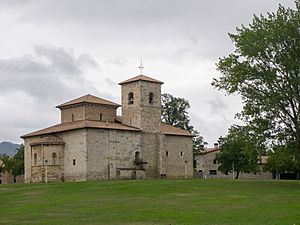
The city of Vitoria-Gasteiz includes many smaller villages. These villages are called concejos and have some local control over their own areas.
- Abetxuko
- Aberásturi
- Amarita
- Andollu
- Antezana/Andetxa
- Aranbizkarra
- Arangiz
- Arkauti - Arcaute
- Arkaia
- Aretxabaleta
- Argandoña
- Aríñez - Ariñiz
- Armentia
- Arriaga
- Askartza
- Asteguieta
- Berrostegieta
- Betoño
- Bolibar
- Castillo - Gaztelu
- Ehari-Ali
- Elorriaga
- Eskibel
- Estarrona
- Foronda
- Gamarra Mayor - Gamarra Nagusia
- Gamarra Menor - Gamarra Gutxia
- Gamiz
- Gardelegi
- Gobeo
- Gometxa
- Guereña
- Hueto Abajo - Otobarren
- Hueto Arriba - Otogoien
- Ilarratza
- Jungitu
- Krispiña - Crispijana
- Lasarte
- Legarda
- Lermanda
- Lopidana
- Lubiano
- Margarita
- Martioda
- Matauko
- Mendiguren
- Mendiola
- Mendoza
- Miñano Mayor - Miñao
- Miñano Menor - Miñao Gutxia
- Monasterioguren
- Oreitia
- Otazu
- Retana
- Subijana de Álava - Subillana-Gasteiz
- Ullíbarri Arrazua
- Ullibarri de los Olleros - Uribarri Nagusia
- Ullibarri-Viña - Uribarri-Dibiña
- Villafranca
- Yurre-Ihurre
- Zerio
- Zuazo de Vitoria - Zuhatzu
- Zumeltzu
Fun Places to Visit
Vitoria-Gasteiz has many cool places to explore:
- The Old Cathedral is a Gothic building from the 14th century. It has beautiful statues and paintings by famous artists like Rubens. This cathedral is being restored, and experts from all over the world come to study it!
- The New Cathedral was built in the 20th century in a Gothic style.
- Andre Maria Zuriaren plaza/Plaza de la Virgen Blanca is a lively square. It's surrounded by old houses with glass balconies. In the middle, there's a monument remembering the Battle of Vitoria.
- The Diocesan Museum of Sacred Art of Álava has a collection of religious art from the province.
- The Church of St. Peter the Apostle (14th century) is a Gothic church with cool carvings.
- The Church of St. Michael the Archangel (14th–16th centuries) has a statue of the Virgen Blanca, who is the city's patron saint.
- The Church of San Vicente Mártir is another Gothic building from the 15th and 16th centuries.
- The Basilica of San Prudencio was first built in the 12th century and rebuilt in the 18th century.
- The Sanctuary of Nuestra Señora of Estibaliz is about 8 km from the city and dates back to the 11th century.
- The Casa del Cordón is an old Gothic house from the 15th century. Important people like the Catholic Monarchs and Pope Adrian VI stayed here.
- The Basque Museum of Contemporary Art (Artium) has one of the best collections of modern art in Spain.
- The Museum of Natural Sciences is in the medieval Tower of Otxanda Andrea. It's a great place to learn about nature.
- The Museum of Archaeology shows off ancient items like dolmens and Roman sculptures found in Álava.
- The Fournier Museum of Playing Cards is in the Bendaña palace. Vitoria-Gasteiz is famous for making playing cards, and this museum has over 6,000 of them!
- The Museum of Fine Arts is in a beautiful old mansion. It has paintings from the 14th century to modern times.
- The Arms Museum of Álava displays weapons from different time periods, from ancient axes to modern handguns. It also has a special section about the Battle of Vitoria.
- Montehermoso Cultural Center is a place for art shows and music performances.
- Plaza de España or Plaza Nueva is a big square with arches, designed in 1781.
- Plaza de los Fueros is a triangular square used for markets and events.
- The Ajuria Enea building is where the President of the Basque Government lives and works. It's a beautiful example of Basque architecture from 1918.
- Ataria is a special center where you can learn about the wetlands of Salburua, a cool nature park.
- The Sequoia of Vitoria-Gasteiz is a huge, 40-meter-tall tree that's over 160 years old!
- The Victims of Terrorism Memorial Centre opened in 2021.
City Life and Jobs
Vitoria-Gasteiz has a strong and varied economy. Many big companies have factories and offices here, like Mercedes-Benz, Michelin (tires), Gamesa (wind energy), and Heraclio Fournier (playing cards).
The city is often ranked as one of the best places to live in Spain. It has lots of green spaces and cultural spots for everyone to enjoy.
Culture and Fun

Music Events
Vitoria-Gasteiz hosts two big international music festivals every year:
- The International Music Festival/Course Vitoria-Gasteiz happens in August.
- The Vitoria-Gasteiz Jazz Festival takes place in July.
- The Azkena rock festival is a rock music festival held in June.
Local Celebrations
The Andre Maria Zuriaren jaiak/Fiestas de la Virgen Blanca festival is celebrated every year from August 4th to 9th. It honors the city's patron saint and includes special events, activities, and free outdoor concerts.
The San Prudencio Festival is also celebrated in late April. Plus, each neighborhood has its own festival, usually between April and September.
Universities and Learning
The University of the Basque Country has a campus in Vitoria-Gasteiz. Here, students can study history, languages, pharmacy, and other subjects. This campus started way back in 1847.
A new private university, European University Gasteiz, opened in 2022. It focuses on health, sports, and new technologies.
Getting Around
Public Transport
Getting around Vitoria-Gasteiz is easy! The city has a city bus service with 10 lines. There's also a tram network with two lines.
Roads
Vitoria-Gasteiz is well connected by roads to other major cities in Spain, like Bilbao and Madrid. The A-1 motorway connects Vitoria-Gasteiz to Madrid and San Sebastián.
Trains
The Vitoria-Gasteiz railway station is an important stop on the train line from Madrid to Hendaye. You can take a fast train (called Alvia) to Madrid in about 3 hours. There are also trains to Barcelona.
There are plans for a new high-speed train network called the Basque Y. This will connect Vitoria-Gasteiz to the French border, San Sebastián, and Bilbao very quickly.
Air Travel
Vitoria Airport is mainly used for cargo (shipping goods), but it also has some flights for passengers. Bilbao Airport is also nearby, about 50 minutes away by car, and a direct bus line from Vitoria-Gasteiz will start in 2024.
City Design
Vitoria-Gasteiz is a medium-sized city with a design that has changed over time. The medieval part of the city is shaped like an almond and sits on a hill. This hill was a good defensive spot long ago. The old city has narrow streets and houses built close together, following the shape of the old medieval walls.
In the 19th century, the city needed to grow. So, new parts were planned in a neoclassical style, with wide streets and beautiful gardens like the La Florida Park.
Today, new neighborhoods like Lakua, Salburua, and Zabalgan have been built. These areas focus on parks, recreation, and a good quality of life. The city has won awards for its urban planning.
A special feature is the "green ring," which is a network of parks and green spaces all around the city. It's like the city's "lungs" and connects the city with the countryside. This ring includes parks like Salburua, Zabalgana, and Armentia.
Sports in the City
Vitoria-Gasteiz is home to several sports teams:
- Deportivo Alavés is a football (soccer) team. They play their home matches at the Mendizorrotza Stadium. They also have a women's team.
- Baskonia is a very successful basketball team. They have won the Spanish league four times! They play their home games at the Fernando Buesa Arena.
- Araski is a women's basketball team that plays in the top Spanish league.
The city also hosts an 'Ironman Vitoria-Gasteiz' triathlon every year. This is a tough race that includes swimming, biking, and running!
A Green City
Vitoria-Gasteiz was named the European Green Capital in 2012. This is because it has so many green public areas. Almost everyone in the city lives within 300 meters of a green space! The city also has great plans for protecting its nature and ecosystems.
Sister Cities
Vitoria-Gasteiz is connected with other cities around the world, called "sister cities":
Famous People from Vitoria-Gasteiz
Many notable people come from Vitoria-Gasteiz:
- Miguel Ricardo de Álava (1770–1843), a general who fought in famous battles like Trafalgar and Waterloo.
- Ramiro de Maeztu (1875–1936), a writer and journalist.
- Martín Fiz (1963), a world champion marathon runner in 1995.
- Karmele Jaio (born 1970), a writer and journalist.
- Iker Jiménez (1973), a journalist.
- Eneko Pou (1974) and Iker Pou (1977), famous free solo climbers.
- Tania Lamarca (1980), Estíbaliz Martínez (1980), and Lorena Guréndez (1981) are rhythmic gymnasts who won Olympic gold medals in 1996.
- Almudena Cid (1980), a rhythmic gymnast who competed in four Olympic finals!
See also
 In Spanish: Vitoria para niños
In Spanish: Vitoria para niños









